author - "Edgar Rice Burroughs"

thin a tiny oasis. Close by was an Arab douar of some eight or ten tents.
I had come down from the north to hunt lion. My party consisted of a dozen children of the desert--I was the only "white" man. As we approached the little clump of verdure I saw the man come from his tent and with hand-shaded eyes peer intently at us. At sight of me he advanced rapidly to meet us.
"A white man!" he cried. "May the good Lord be praised! I have been watching you for hours, hoping against hope that THIS time there would be a white man. Tell me the date. What year is it?"
And when I had told him he staggered as though he had been struck full in the face, so that he was compelled to grasp my stirrup leather for support.
"It cannot be!" he cried after a moment. "It cannot be! Tell me that you are mistaken, or that you are but joking."
"I am telling you the truth, my friend," I replied. "Why should I deceive a stranger, or attempt to, in so simple a matter as the date?"
For some time h

e crack of a shot, and the sheriffs gun dropped from his hand. All eyes turned in the direction of the entrance. There stood Texas Pete, his shooting iron smoking in his hand.
"You damn pole-cat!" he exclaimed, his eyes on Gum. "Come on, Bull; this ain't no place for quiet young fellers like us."
Bull wheeled Blazes and rode slowly through the doorway, with never a glance toward the sheriff; nor could he better have shown his utter contempt for the man. There had always been bad blood between them. Smith had been elected by the lawless element of the community and at the time of the campaign Bull had worked diligently for the opposing candidate who had been backed by the better element, consisting largely of the cattle owners, headed by Elias Henders.
What Bull's position would have been had he not been foreman for Henders at the time was rather an open question among the voters of Hendersville, but the fact remained that he had been foreman and that he had worked to such good purpose for
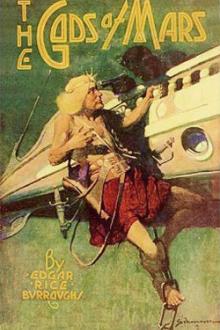
sult of its peculiar method of feeding, which consists in cropping off the tender vegetation with its razorlike talons and sucking it up from its two mouths, which lie one in the palm of each hand, through its arm-like throats.
In addition to the features which I have already described, the beast was equipped with a massive tail about six feet in length, quite round where it joined the body, but tapering to a flat, thin blade toward the end, which trailed at right angles to the ground.
By far the most remarkable feature of this most remarkable creature, however, were the two tiny replicas of it, each about six inches in length, which dangled, one on either side, from its armpits. They were suspended by a small stem which seemed to grow from the exact tops of their heads to where it connected them with the body of the adult.
Whether they were the young, or merely portions of a composite creature, I did not know.
As I had been scrutinizing this weird monstrosity the balance of the he

ship, or meddling in affairs that don't concern you you can take the consequences, and be damned. I don't care whether you are an English lord or not. I'm captain of this here ship, and from now on you keep your meddling nose out of my business."
The captain had worked himself up to such a frenzy of rage that he was fairly purple of face, and he shrieked the last words at the top of his voice, emphasizing his remarks by a loud thumping of the table with one huge fist, and shaking the other in Clayton's face.
Greystoke never turned a hair, but stood eying the excited man with level gaze.
"Captain Billings," he drawled finally, "if you will pardon my candor, I might remark that you are something of an ass."
Whereupon he turned and left the captain with the same indifferent ease that was habitual with him, and which was more surely calculated to raise the ire of a man of Billings' class than a torrent of invective.
So, whereas the captain might easily have been brought to regr
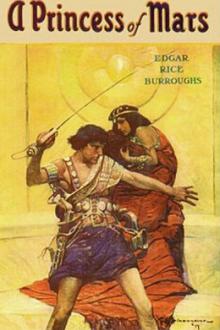
however, that this thought did not occur to me until the following day removes any possible right to a claim to heroism to which the narration of this episode might possibly otherwise entitle me.
I do not believe that I am made of the stuff which constitutes heroes, because, in all of the hundreds of instances that my voluntary acts have placed me face to face with death, I cannot recall a single one where any alternative step to that I took occurred to me until many hours later. My mind is evidently so constituted that I am subconsciously forced into the path of duty without recourse to tiresome mental processes. However that may be, I have never regretted that cowardice is not optional with me.
In this instance I was, of course, positive that Powell was the center of attraction, but whether I thought or acted first I do not know, but within an instant from the moment the scene broke upon my view I had whipped out my revolvers and was charging down upon the entire army of warriors, shooting
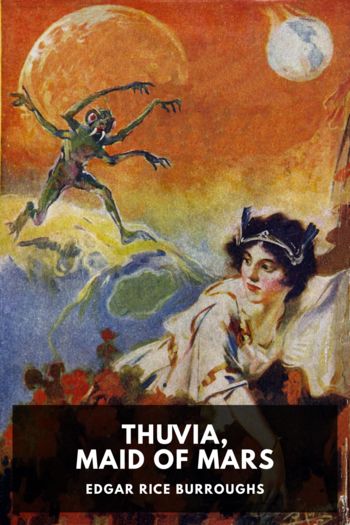
Description
Thuvia, Maid of Mars moves the focus of Burroughs’ Martian series to Carthoris, the son of the human John Carter and Martian Dejah Thoris and the prince of Helium.
Princess Thuvia of Ptarth and Prince Carthoris of Helium are in love. Fate, however, is against them: the princess is promised to another, the Jeddak of Kaol, Kulan Tith. So when the princess is kidnapped, suspicion falls on Carthoris, who sets out as his father would have to rescue the damsel and clear his name. As the great airborn navies of Mars’ military powers charge inexorably towards a needless war, Carthoris pursues the imperiled princess across borders and battlefields, making new enemies and allies along the way on a journey which traverses far and forgotten corners of Barsoom.
Thuvia, Maid of Mars presents many familiar themes from Burroughs’ books, such as damsels in distress, fantastical adventures, chivalry, and derring-do, set against a backdrop of looming war and political intrigue. But it also introduces new elements, such as psychic armies and new flight technologies, as well as bringing entirely new races and settings to the series. It was originally published in 1916 as three serialized parts in All-Story Weekly, and published as a novel in 1920.

Description
The Land That Time Forgot opens with the discovery near Greenland of a floating thermos flask containing a manuscript by castaway Tyler Bowen, Jr. The document recounts a series of adventures that starts with a sea battle against a German U-boat and ends on a mysterious island populated by hostile prehistoric animals and people.
The second part of the book, “The People That Time Forgot,” continues the story with the tale of Tom Billings, who has been sent on a mission to rescue Bowen after his manuscript was discovered. He flies solo over the mountainous cliffs that encircle the island and is attacked by a monstrous flying reptile, forcing him to crash-land. Billings then attempts to make his way on foot back to the rest of his party while contending with dangerous inhabitants from different stages of human development.
The final installment of the story, “Out of Time’s Abyss,” reveals what happened to Bradley, a crew member who was sent on a scouting expedition earlier in the story and was never heard from again.
This trilogy of short novels was originally published serially in 1918 in Blue Book Magazine. In 1924 they were published in a single volume by A. C. McClurg. The Burroughs fan community seems to fall into two camps about whether the story comprises three separate novellas, or whether it’s a single novel divided into three parts. This production follows the 1924 edition in combining the three into a single novel.

Description
Pellucidar, the sequel to At the Earth’s Core, was published in 1915. It continues the adventures of David Innes as he returns to the hollow interior of the Earth in search of his friend Perry and his lost love Dian the Beautiful. He takes with him many tools and weapons, intent on bringing civilization to the savage world within, which is populated with dinosaurs and neolithic creatures. He has many perilous adventures as he battles to survive.
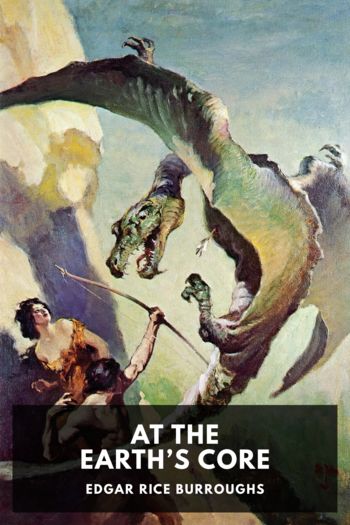
Description
At the Earth’s Core, published in 1914, is the first of a series of science fiction novels written by Edgar Rice Burroughs set inside a hollow earth with a central “sun,” a land called Pellucidar. However unlikely this scenario, it allowed Burroughs free play to create heroic adventures in yet another alien environment in addition to his fantastic version of Mars in his Martian series.
The story’s hero, David Innes, is recruited by an old man, Perry, to help fund his invention, a “mechanical subterranean prospector,” and then to test it out. Unfortunately once the powerful burrowing machine is set going, it cannot be steered, and the pair find themselves burrowing deeper and deeper into the Earth’s crust. To their astonishment, rather than dying from suffocation or increasing heat, they emerge inside a hollow shell inside the Earth. This world is populated by prehistoric creatures as well as primitive humans, intelligent gorillas, and supremely intelligent pterosaurs, the masters of this land. David and Perry are captured by these creatures and many adventures ensue.
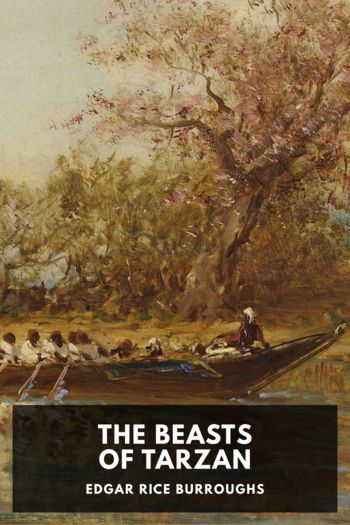
Description
The Beasts of Tarzan, the third book in the Tarzan series, was first published in All-Story Cavalier magazine in 1914. It was later published as a novel in 1916.
Tarzan’s old enemy, Nikolas Rokoff, escapes prison and plans his revenge by kidnapping the Tarzan’s son, the heir of Greystoke. He also captures Tarzan and Jane, and takes them all back to Africa, where he strands the Ape-man on an island before continuing on with his dastardly plan. On the island prison Tarzan befriends a troop of apes led by Akut and tames Sheeta the panther before escaping and setting off to rescue his wife and child.

thin a tiny oasis. Close by was an Arab douar of some eight or ten tents.
I had come down from the north to hunt lion. My party consisted of a dozen children of the desert--I was the only "white" man. As we approached the little clump of verdure I saw the man come from his tent and with hand-shaded eyes peer intently at us. At sight of me he advanced rapidly to meet us.
"A white man!" he cried. "May the good Lord be praised! I have been watching you for hours, hoping against hope that THIS time there would be a white man. Tell me the date. What year is it?"
And when I had told him he staggered as though he had been struck full in the face, so that he was compelled to grasp my stirrup leather for support.
"It cannot be!" he cried after a moment. "It cannot be! Tell me that you are mistaken, or that you are but joking."
"I am telling you the truth, my friend," I replied. "Why should I deceive a stranger, or attempt to, in so simple a matter as the date?"
For some time h

e crack of a shot, and the sheriffs gun dropped from his hand. All eyes turned in the direction of the entrance. There stood Texas Pete, his shooting iron smoking in his hand.
"You damn pole-cat!" he exclaimed, his eyes on Gum. "Come on, Bull; this ain't no place for quiet young fellers like us."
Bull wheeled Blazes and rode slowly through the doorway, with never a glance toward the sheriff; nor could he better have shown his utter contempt for the man. There had always been bad blood between them. Smith had been elected by the lawless element of the community and at the time of the campaign Bull had worked diligently for the opposing candidate who had been backed by the better element, consisting largely of the cattle owners, headed by Elias Henders.
What Bull's position would have been had he not been foreman for Henders at the time was rather an open question among the voters of Hendersville, but the fact remained that he had been foreman and that he had worked to such good purpose for

sult of its peculiar method of feeding, which consists in cropping off the tender vegetation with its razorlike talons and sucking it up from its two mouths, which lie one in the palm of each hand, through its arm-like throats.
In addition to the features which I have already described, the beast was equipped with a massive tail about six feet in length, quite round where it joined the body, but tapering to a flat, thin blade toward the end, which trailed at right angles to the ground.
By far the most remarkable feature of this most remarkable creature, however, were the two tiny replicas of it, each about six inches in length, which dangled, one on either side, from its armpits. They were suspended by a small stem which seemed to grow from the exact tops of their heads to where it connected them with the body of the adult.
Whether they were the young, or merely portions of a composite creature, I did not know.
As I had been scrutinizing this weird monstrosity the balance of the he

ship, or meddling in affairs that don't concern you you can take the consequences, and be damned. I don't care whether you are an English lord or not. I'm captain of this here ship, and from now on you keep your meddling nose out of my business."
The captain had worked himself up to such a frenzy of rage that he was fairly purple of face, and he shrieked the last words at the top of his voice, emphasizing his remarks by a loud thumping of the table with one huge fist, and shaking the other in Clayton's face.
Greystoke never turned a hair, but stood eying the excited man with level gaze.
"Captain Billings," he drawled finally, "if you will pardon my candor, I might remark that you are something of an ass."
Whereupon he turned and left the captain with the same indifferent ease that was habitual with him, and which was more surely calculated to raise the ire of a man of Billings' class than a torrent of invective.
So, whereas the captain might easily have been brought to regr

however, that this thought did not occur to me until the following day removes any possible right to a claim to heroism to which the narration of this episode might possibly otherwise entitle me.
I do not believe that I am made of the stuff which constitutes heroes, because, in all of the hundreds of instances that my voluntary acts have placed me face to face with death, I cannot recall a single one where any alternative step to that I took occurred to me until many hours later. My mind is evidently so constituted that I am subconsciously forced into the path of duty without recourse to tiresome mental processes. However that may be, I have never regretted that cowardice is not optional with me.
In this instance I was, of course, positive that Powell was the center of attraction, but whether I thought or acted first I do not know, but within an instant from the moment the scene broke upon my view I had whipped out my revolvers and was charging down upon the entire army of warriors, shooting

Description
Thuvia, Maid of Mars moves the focus of Burroughs’ Martian series to Carthoris, the son of the human John Carter and Martian Dejah Thoris and the prince of Helium.
Princess Thuvia of Ptarth and Prince Carthoris of Helium are in love. Fate, however, is against them: the princess is promised to another, the Jeddak of Kaol, Kulan Tith. So when the princess is kidnapped, suspicion falls on Carthoris, who sets out as his father would have to rescue the damsel and clear his name. As the great airborn navies of Mars’ military powers charge inexorably towards a needless war, Carthoris pursues the imperiled princess across borders and battlefields, making new enemies and allies along the way on a journey which traverses far and forgotten corners of Barsoom.
Thuvia, Maid of Mars presents many familiar themes from Burroughs’ books, such as damsels in distress, fantastical adventures, chivalry, and derring-do, set against a backdrop of looming war and political intrigue. But it also introduces new elements, such as psychic armies and new flight technologies, as well as bringing entirely new races and settings to the series. It was originally published in 1916 as three serialized parts in All-Story Weekly, and published as a novel in 1920.

Description
The Land That Time Forgot opens with the discovery near Greenland of a floating thermos flask containing a manuscript by castaway Tyler Bowen, Jr. The document recounts a series of adventures that starts with a sea battle against a German U-boat and ends on a mysterious island populated by hostile prehistoric animals and people.
The second part of the book, “The People That Time Forgot,” continues the story with the tale of Tom Billings, who has been sent on a mission to rescue Bowen after his manuscript was discovered. He flies solo over the mountainous cliffs that encircle the island and is attacked by a monstrous flying reptile, forcing him to crash-land. Billings then attempts to make his way on foot back to the rest of his party while contending with dangerous inhabitants from different stages of human development.
The final installment of the story, “Out of Time’s Abyss,” reveals what happened to Bradley, a crew member who was sent on a scouting expedition earlier in the story and was never heard from again.
This trilogy of short novels was originally published serially in 1918 in Blue Book Magazine. In 1924 they were published in a single volume by A. C. McClurg. The Burroughs fan community seems to fall into two camps about whether the story comprises three separate novellas, or whether it’s a single novel divided into three parts. This production follows the 1924 edition in combining the three into a single novel.

Description
Pellucidar, the sequel to At the Earth’s Core, was published in 1915. It continues the adventures of David Innes as he returns to the hollow interior of the Earth in search of his friend Perry and his lost love Dian the Beautiful. He takes with him many tools and weapons, intent on bringing civilization to the savage world within, which is populated with dinosaurs and neolithic creatures. He has many perilous adventures as he battles to survive.

Description
At the Earth’s Core, published in 1914, is the first of a series of science fiction novels written by Edgar Rice Burroughs set inside a hollow earth with a central “sun,” a land called Pellucidar. However unlikely this scenario, it allowed Burroughs free play to create heroic adventures in yet another alien environment in addition to his fantastic version of Mars in his Martian series.
The story’s hero, David Innes, is recruited by an old man, Perry, to help fund his invention, a “mechanical subterranean prospector,” and then to test it out. Unfortunately once the powerful burrowing machine is set going, it cannot be steered, and the pair find themselves burrowing deeper and deeper into the Earth’s crust. To their astonishment, rather than dying from suffocation or increasing heat, they emerge inside a hollow shell inside the Earth. This world is populated by prehistoric creatures as well as primitive humans, intelligent gorillas, and supremely intelligent pterosaurs, the masters of this land. David and Perry are captured by these creatures and many adventures ensue.

Description
The Beasts of Tarzan, the third book in the Tarzan series, was first published in All-Story Cavalier magazine in 1914. It was later published as a novel in 1916.
Tarzan’s old enemy, Nikolas Rokoff, escapes prison and plans his revenge by kidnapping the Tarzan’s son, the heir of Greystoke. He also captures Tarzan and Jane, and takes them all back to Africa, where he strands the Ape-man on an island before continuing on with his dastardly plan. On the island prison Tarzan befriends a troop of apes led by Akut and tames Sheeta the panther before escaping and setting off to rescue his wife and child.